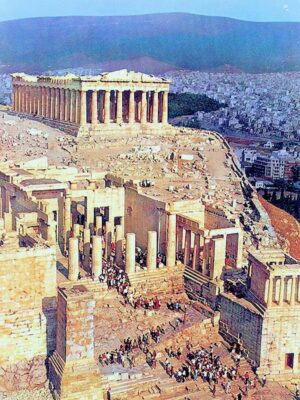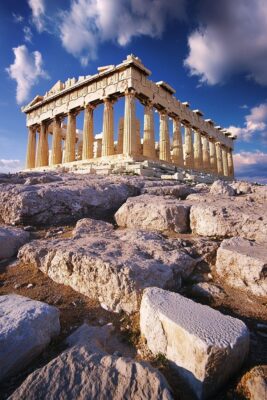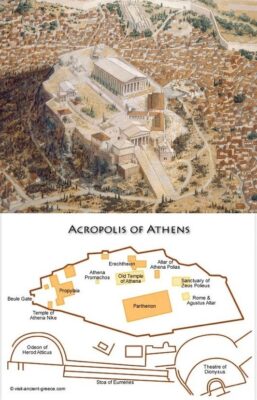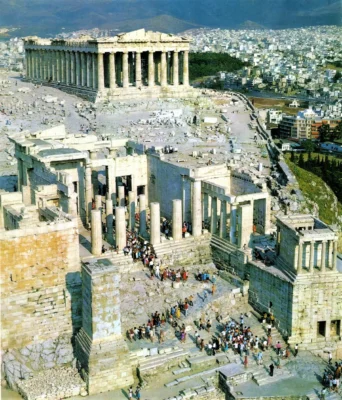The Acropolis of Athens, a shining beacon of ancient Greek civilization, has long been a symbol of grandeur, cultural innovation, and architectural mastery. This iconic site, dedicated primarily to the goddess Athena, stands tall in the heart of modern Athens, reminding us of the city’s glorious past. Let’s delve into the fascinating history, transformation, and enduring legacy of this ancient marvel. Follow archeology.dulichvn.net to discover many hidden mysteries that have yet to be discovered.

The Historical Foundations The Acropolis of Athens
Early Beginnings: From Neolithic to Mycenaean Eras
The story of the Acropolis begins in the Neolithic period (4000/3500-3000 BC), evidenced by pottery fragments discovered on the rocky hill. By the 13th century BC, early fortifications established the site as the center of a Mycenaean kingdom, complete with palaces and defensive walls.
The Sacred Shift in the 8th Century BC
In the 8th century BC, the Acropolis transitioned from a fortified settlement to a sacred space. The cult of Athena Polias emerged, marking the hill as a spiritual center. This era saw the construction of early monumental temples dedicated to the city’s patron goddess.
The Rise of Religious and Cultural Significance
Under Peisistratos in the 6th century BC, Athens’ cultural and religious life flourished. The establishment of the Panathenaia festival celebrated Athena, and grand temples began to dot the Acropolis, setting the stage for its golden age.

The Golden Age of the Acropolis
Rebuilding After the Persian Wars
In the 5th century BC, after the defeat of the Persians, Athens entered a period of immense prosperity. The Parthenon’s construction began during this era, symbolizing Athens’ power and resilience. Despite being partially destroyed during the Persian invasion of 480 BC, the Athenians fortified the Acropolis and salvaged invaluable artworks.
Pericles and the Architectural Masterpieces
Under Pericles’ leadership, the Acropolis became a masterpiece of Classical architecture. Iconic structures such as the Parthenon, the Propylaia, the Erechtheion, and the Temple of Athena Nike were constructed. These buildings, designed by the finest architects and sculptors, showcased Athens’ wealth and artistic innovation.
Cultural Symbolism of Athena
The Acropolis celebrated Athena in various forms—goddess of wisdom, war, and victory. The structures built during this period not only reflected the city’s devotion to its patron goddess but also stood as symbols of Athens’ dominance in the Greek world.

The Acropolis Through the Ages
Post-Golden Age Decline and Roman Additions
After the Peloponnesian War, major construction ceased on the Acropolis. However, in 27 BC, the Romans built a small temple dedicated to Augustus and Rome near the Parthenon, blending Roman influence with Greek heritage.
Religious and Cultural Evolution
Over centuries, the Acropolis adapted to the changing tides of religion and culture. From a pagan sanctuary to a Christian site and later an Ottoman mosque, the Acropolis reflected the diversity of civilizations that claimed Athens.
Modern-Day Symbol of Greek Legacy
Today, the Acropolis stands as a global symbol of ancient Greece’s enduring impact on art, philosophy, and governance. Its ruins, though weathered by time, continue to inspire awe among millions of visitors annually.

The Architectural Splendor of the Acropolis
The Parthenon: A Monument of Perfection
The Parthenon, dedicated to Athena Parthenos, is the crowning glory of the Acropolis. Its intricate sculptures and precise proportions exemplify the pinnacle of Classical architecture.
The Propylaia: The Grand Gateway
The Propylaia served as the monumental entrance to the Acropolis. Its blend of Doric and Ionic elements highlights the architectural sophistication of the era.
The Erechtheion and Temple of Athena Nike
The Erechtheion, with its iconic Caryatids, and the Temple of Athena Nike, celebrating victory, add to the Acropolis’s architectural diversity and spiritual significance.
See more: The Scarab Pectoral from Tutankhamun’s Tomb: A Symbol of Rebirth
Conclusion: A Timeless Testament to Human Achievement
The Acropolis of Athens is more than a collection of ruins; it is a living testament to the ingenuity, resilience, and cultural richness of ancient Greece. From its origins as a Mycenaean fortress to its transformation into a sacred sanctuary, the Acropolis reflects the evolution of Athens and its enduring legacy.
Why the Acropolis Matters Today
Visiting the Acropolis is not just a journey into history; it’s an opportunity to connect with the roots of Western civilization. Its stories, myths, and achievements continue to inspire and educate generations worldwide.
Discover the Acropolis of Athens—where the past meets the present, and the spirit of ancient Greece lives on


CÁC TIN KHÁC
Mark Twain & Olivia Langdon: A 36-Year Love Story Filled with Laughter and Devotion
The Tollund Man: A 2,400-Year-Old Mystery Preserved in a Danish Bog
Skara Brae: Scotland’s Hidden Neolithic Village
Porta Nigra: The Hidden Depths of Trier’s Iconic Roman Gate